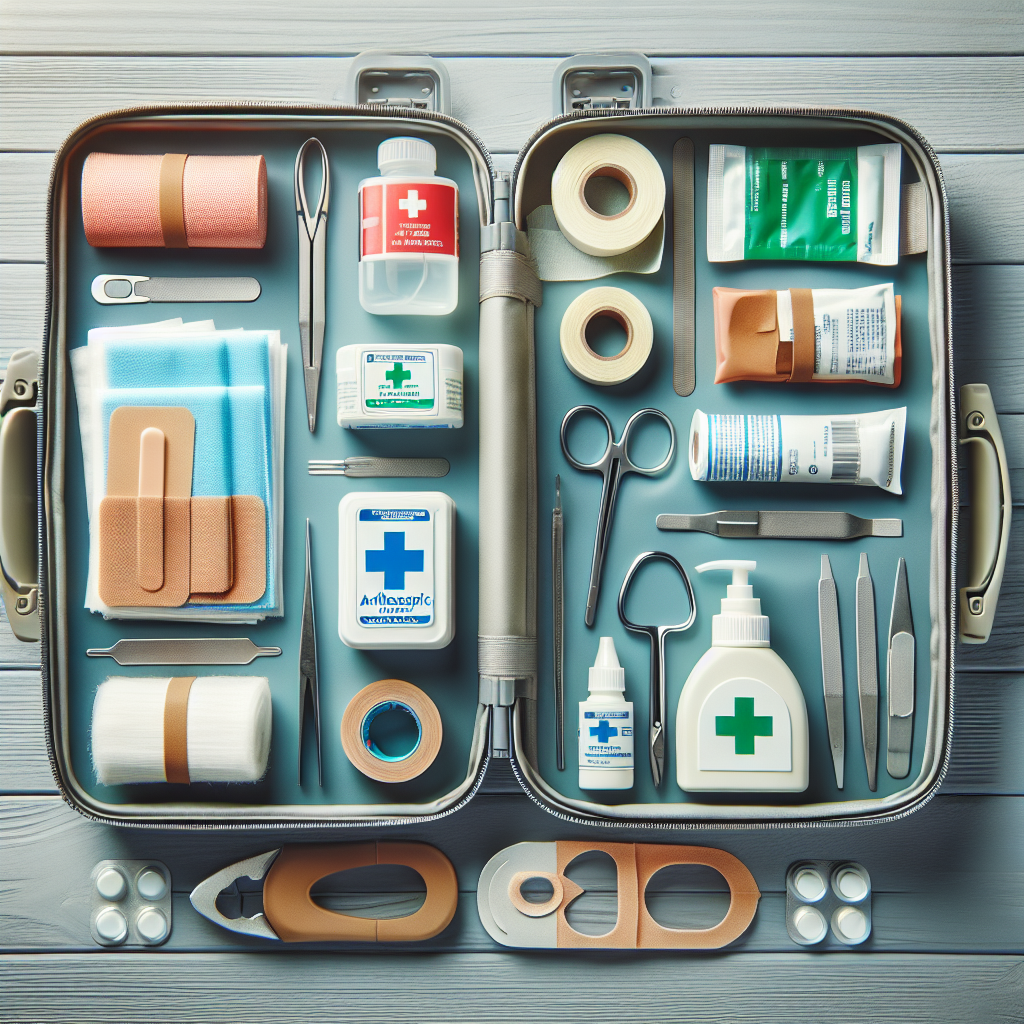
In this informative article, you will discover essential tips to help you identify and effectively manage common injuries and illnesses encountered in outdoor settings. Whether you enjoy hiking, camping, or simply spending time in nature, knowing how to recognize and properly treat these ailments is crucial for your safety and well-being. By equipping yourself with the knowledge and tools outlined here, you will be better prepared to handle various outdoor medical situations with confidence and ease.
Recognizing and Treating Common Outdoor Injuries and Illnesses
When you spend time outdoors, whether it be for hiking, camping, or any other outdoor activity, there is always a risk of injuries and illnesses. Being aware of the signs and symptoms of these common outdoor injuries and illnesses can help you promptly recognize them and take the appropriate steps for treatment. In this article, we will discuss some of the most common outdoor injuries and illnesses and provide guidance on how to recognize and treat them effectively.
Head Injuries
Head injuries can occur during various outdoor activities, especially those that involve fast movements or potential falls. It is crucial to recognize the signs and symptoms of a head injury as they can range from mild to severe. Some common signs include headache, dizziness, confusion, nausea, blurred vision, and loss of consciousness. If you or someone you know experiences any of these symptoms after a head injury, it is important to seek medical attention immediately.
In the case of a head injury, it is crucial to follow the appropriate first aid procedures. Make sure the injured person stays still and avoids any physical activities or exertion. Apply a cold compress or ice pack wrapped in a cloth to the affected area to reduce swelling. Avoid giving any medications unless specifically instructed by a healthcare professional.
Cuts and Abrasions
Cuts and abrasions are common injuries that can occur during outdoor activities, particularly when handling sharp objects or engaging in activities with rough surfaces. Recognizing the signs of these injuries is essential to prevent infection and promote proper healing. Signs of cuts and abrasions include pain, bleeding, swelling, redness, and the presence of debris in the wound.
To treat cuts and abrasions, begin by cleaning the wound with mild soap and water, gently removing any debris. Apply an antibiotic ointment and cover the wound with a sterile bandage or dressing to protect it from further contamination. Replace the dressing regularly and monitor the wound for signs of infection, such as increased pain, redness, swelling, or pus.
Sprains and Strains
Sprains and strains are common injuries that can occur when engaging in physical activities that involve sudden movements or excessive force on the joints and muscles. Recognizing the signs and symptoms of these injuries is crucial in order to apply the appropriate first aid and prevent further damage. Common signs of sprains and strains include pain, swelling, bruising, limited range of motion, and difficulty bearing weight on the affected area.
To provide first aid for sprains and strains, remember the acronym RICE: Rest, Ice, Compression, and Elevation. Allow the injured person to rest and avoid any activities that may exacerbate the injury. Apply an ice pack wrapped in a cloth to the affected area for 20 minutes every 2-3 hours to reduce swelling. Use compression bandages to support the injured area and elevate it above heart level to minimize swelling.
Broken Bones
Fractures or broken bones can occur during outdoor activities, particularly in situations where there is a risk of falls, collisions, or high-impact forces. Recognizing the signs and symptoms of a broken bone is crucial as prompt medical attention is often necessary. Signs of a fracture include severe pain, visible deformity, swelling, bruising, inability to bear weight or move the affected area, and a snapping or grinding sensation during the injury.
When faced with a suspected broken bone, it is essential to immobilize the injured area to prevent further damage. Avoid moving or attempting to realign the bone. Create a splint using any rigid material like a board or rolled-up newspaper to immobilize the injured area. Apply ice packs wrapped in a cloth to reduce swelling and seek immediate medical attention as fractures often require professional treatment.
Heat Exhaustion
Heat exhaustion is a common heat-related illness that can occur during outdoor activities, particularly in hot and humid conditions. It is crucial to recognize the signs and symptoms of heat exhaustion, as failure to do so can progress to a more severe condition called heatstroke. Signs of heat exhaustion include excessive sweating, weakness, dizziness, headache, nausea, vomiting, muscle cramps, and rapid heartbeat.
To provide first aid for heat exhaustion, it is important to move to a cool and shaded area and immediately remove any excessive clothing. Drink plenty of fluids, preferably water or sports drinks with electrolytes, to rehydrate the body. Apply cool, wet cloths or use a fan to lower body temperature. If symptoms worsen or do not improve within 30 minutes, seek medical attention.
Dehydration
Dehydration is another common condition that can occur during outdoor activities, particularly in hot climates or when engaging in high-intensity physical activities. Recognizing the signs and symptoms of dehydration can help in initiating proper treatment and preventing complications. Common signs include excessive thirst, dry mouth, fatigue, dizziness, dark-colored urine, and decreased urine output.
The first step in treating dehydration is to consume fluids immediately. Water is the best choice for mild to moderate cases. If the dehydration is severe or prolonged, including cases with symptoms such as confusion or loss of consciousness, oral rehydration solutions or intravenous fluids may be necessary. Rest and seek shade or air conditioning to minimize further fluid loss.
Insect Bites and Stings
Insect bites and stings are common outdoor nuisances and can cause varying degrees of discomfort and allergic reactions. Recognizing the signs and symptoms of an insect bite or sting can help in determining the appropriate course of treatment. Common signs include localized pain, swelling, redness, itching, and the presence of a raised bump or blister at the site of the bite or sting.
To treat insect bites and stings, begin by gently washing the area with soap and water. Apply a cold compress or ice pack wrapped in a cloth to reduce pain and swelling. Over-the-counter topical creams or ointments containing antihistamines or hydrocortisone can help alleviate itching. If an allergic reaction occurs, such as difficulty breathing or widespread hives, seek immediate medical attention.
Poison Ivy, Oak, and Sumac
Encountering plants such as poison ivy, poison oak, or poison sumac during outdoor activities can lead to an uncomfortable and itchy rash. Recognizing the signs and symptoms is crucial for proper treatment and to prevent spreading the rash to other areas of the body. Common signs of exposure to these plants include redness, itching, swelling, and the appearance of a linear rash consisting of small, fluid-filled blisters.
To treat poison ivy, oak, or sumac exposure, begin by washing the affected area with cool water and mild soap to remove any remaining plant oils. Apply over-the-counter hydrocortisone cream or calamine lotion to alleviate itching and inflammation. Avoid scratching the rash to prevent further complications or infection. If the rash covers a large area, occurs on the face or genitals, or is associated with severe swelling or difficulty breathing, seek medical attention.
Sunburn
Sunburn is a common consequence of prolonged exposure to the sun’s ultraviolet rays without adequate protection. Recognizing the signs and symptoms of sunburn can help in initiating proper treatment and preventing further damage to the skin. Common signs of sunburn include redness, pain, swelling, blistering, and peeling of the affected skin.
When treating sunburn, it is important to cool the affected area. Take a cool bath or shower, or apply cool compresses to the sunburned skin. Avoid further sun exposure and wear loose, breathable clothing to prevent further irritation. Over-the-counter pain relievers like ibuprofen or aspirin can help alleviate discomfort. Moisturizing creams or aloe vera gel can also provide relief and promote healing.
Hypothermia
Hypothermia occurs when the body loses heat faster than it can produce, resulting in a dangerously low body temperature. This condition can occur during outdoor activities in cold weather or when exposed to extreme wetness without proper protection. Recognizing the signs and symptoms of hypothermia is critical as it can be life-threatening. Common signs include shivering, cold and pale skin, confusion, fatigue, slurred speech, and slow heartbeat.
To provide first aid for hypothermia, it is crucial to move the person to a warm and dry area. Remove any wet clothing and cover them with dry blankets or clothing while ensuring their head is covered. Provide warm liquids like soups or warm water, but avoid alcohol or caffeine. Seek immediate medical attention as hypothermia requires professional treatment to prevent severe complications.
In conclusion, being knowledgeable about the signs, symptoms, and appropriate treatments for common outdoor injuries and illnesses is crucial for anyone engaging in outdoor activities. Proper recognition and prompt treatment of these conditions can prevent further complications and ensure a safer and more enjoyable outdoor experience. Always prioritize safety, stay aware of your surroundings, and be prepared for any potential injuries or illnesses that may arise.







